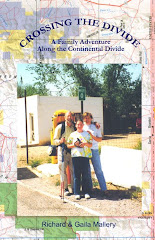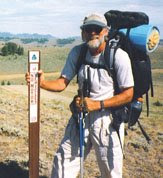 The Amazon Outdoor Store
The Amazon Outdoor StoreThe winter rains arrived with a fury, bringing much-needed water to the Valley's reservoirs and cliche scenes to the evening news: drivers stranded in washes, roofing companies bombarded with calls, golfers running for cover. The sweet perk of a wet winter is a bountiful, colorful desert spring. This year's wildflower season is destined to be great, so it's time to dust off the hiking boots, grab the atlas, fill the canteen and charge up your camera."A good place to see wildflowers is the Superstition Mountains region," says Angelica Elliott, curator of wildflowers at Desert Botanical Garden in Phoenix.
"It is a beautiful area year-round and has great hiking trails for all skill levels. In this area we have seen quite a bit of rainfall, so it should be a pretty good year."Elliott says to set the alarm early for the best show. "Some wildflowers close at night and will open up in the morning once the sunshine wakes them up," she says. "Midmorning is the best time to see them."
Where to see flowersHiking options are plentiful for those willing to hoof it. "Some of the best areas suitable for hikers in the Phoenix area are the Ballantine Trail, which has a trailhead right on the Beeline Highway (Arizona 87), about 2 miles south of the crossing of Sycamore Creek," says Chris Trask, amateur desert-plant horticulturalist and member of the Arizona Invasive Species Advisory Council. Trask also recommends the Arizona Trail in the vicinity of Picketpost Mountain, near Superior. Two more good choices include the Pass Mountain loop in Usery Mountain Regional Park in Mesa, and the Treasure Loop and Siphon Draw trails in Lost Dutchman State Park in Apache Junction.
Be preparedElliott and Trask remind hikers not to skimp on preparation, lest they become one of those embarrassed souls on the evening news, rescued and dehydrated. "Bring water even though temperatures may be moderate," Elliott said. "Keeping hydrated is extremely important in the desert. "Also, bring extra batteries for your digital camera."Trask, a 28-year member of the Sierra Club, says planning is essential for a safe and enjoyable hike."For this time of year, figure on 2 quarts (of water) per person per day. Don't count on finding surface water in the form of running streams, springs or seeps unless you are already familiar with the area," he said."Wear good-fitting shoes with thick soles. Stepping on a cactus spine in sneakers can be a painful and sometimes crippling experience. Wear clothing that is suitable for the temperatures, especially if you intend to be out overnight, as desert temperatures drop rapidly after the sun goes down."As the temperatures climb, rattlesnakes will become more common in the daytime, and you should always wear long pants as a defense against snakebites."
Pack a mapTrask reminds those on a backcountry hunt for a field of wildflowers that Global Positioning System units and cellphones can fail. Having a map on hand is smart. "Obtain a good topographical map," he said. "U.S. Forest Service maps are not detailed anywhere near enough to be considered suitable for backcountry navigation, but they are the best available for driving reference. Maps printed out from software, such as Topo, are as usable as the formal U.S. Geological Service maps."Do not rely on GPS for navigation unless you are using it in conjunction with a good-quality topographical map. Your first navigational reference is the map, along with recognizable geographical features as references, preferably using a magnetic compass or GPS as a backup. I use both."Lastly, he reminds hikers of the cardinal rule: "Always tell someone where you are going to be and provide them with emergency telephone numbers, vehicle descriptions and license-plate numbers so that they can call the proper authorities (county sheriff's office first) in the event that you are overdue. Do not expect to be able to use a cellphone."
"It is a beautiful area year-round and has great hiking trails for all skill levels. In this area we have seen quite a bit of rainfall, so it should be a pretty good year."Elliott says to set the alarm early for the best show. "Some wildflowers close at night and will open up in the morning once the sunshine wakes them up," she says. "Midmorning is the best time to see them."
Where to see flowersHiking options are plentiful for those willing to hoof it. "Some of the best areas suitable for hikers in the Phoenix area are the Ballantine Trail, which has a trailhead right on the Beeline Highway (Arizona 87), about 2 miles south of the crossing of Sycamore Creek," says Chris Trask, amateur desert-plant horticulturalist and member of the Arizona Invasive Species Advisory Council. Trask also recommends the Arizona Trail in the vicinity of Picketpost Mountain, near Superior. Two more good choices include the Pass Mountain loop in Usery Mountain Regional Park in Mesa, and the Treasure Loop and Siphon Draw trails in Lost Dutchman State Park in Apache Junction.
Be preparedElliott and Trask remind hikers not to skimp on preparation, lest they become one of those embarrassed souls on the evening news, rescued and dehydrated. "Bring water even though temperatures may be moderate," Elliott said. "Keeping hydrated is extremely important in the desert. "Also, bring extra batteries for your digital camera."Trask, a 28-year member of the Sierra Club, says planning is essential for a safe and enjoyable hike."For this time of year, figure on 2 quarts (of water) per person per day. Don't count on finding surface water in the form of running streams, springs or seeps unless you are already familiar with the area," he said."Wear good-fitting shoes with thick soles. Stepping on a cactus spine in sneakers can be a painful and sometimes crippling experience. Wear clothing that is suitable for the temperatures, especially if you intend to be out overnight, as desert temperatures drop rapidly after the sun goes down."As the temperatures climb, rattlesnakes will become more common in the daytime, and you should always wear long pants as a defense against snakebites."
Pack a mapTrask reminds those on a backcountry hunt for a field of wildflowers that Global Positioning System units and cellphones can fail. Having a map on hand is smart. "Obtain a good topographical map," he said. "U.S. Forest Service maps are not detailed anywhere near enough to be considered suitable for backcountry navigation, but they are the best available for driving reference. Maps printed out from software, such as Topo, are as usable as the formal U.S. Geological Service maps."Do not rely on GPS for navigation unless you are using it in conjunction with a good-quality topographical map. Your first navigational reference is the map, along with recognizable geographical features as references, preferably using a magnetic compass or GPS as a backup. I use both."Lastly, he reminds hikers of the cardinal rule: "Always tell someone where you are going to be and provide them with emergency telephone numbers, vehicle descriptions and license-plate numbers so that they can call the proper authorities (county sheriff's office first) in the event that you are overdue. Do not expect to be able to use a cellphone."


